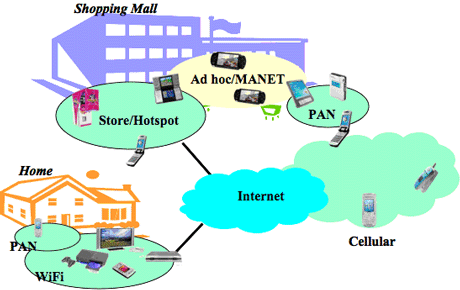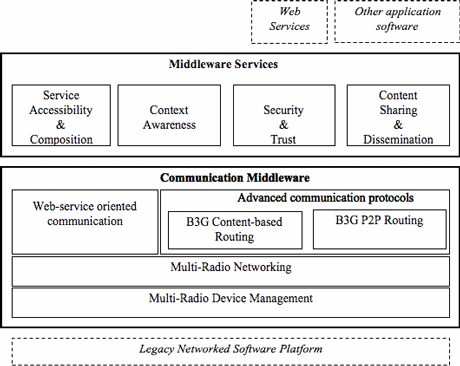by Valerie Issarny, Mauro Caporuscio, Pierre-Guillaume Raverdy
Beyond 3rd Generation (B3G) networking provides mobile users with unique features for seamlessly accessing networked services. However, the provision of services over B3G distributed computing platforms faces numerous challenges, and these are being investigated by the INRIA ARLES project team.
The ARLES (Software Architectures and Distributed Systems) project team at INRIA is investigating solutions to issues that occur as part of the design and development of a service-oriented middleware for B3G networking. These include: (i) developing services that can be easily deployed on a wide range of evolving infrastructures, from networks of devices to stand-alone wireless resource-constrained handheld devices; (ii) making services context-aware so that they can benefit from networked resources and related services in the most effective way; and (iii) ensuring that users always experience the best possible quality of service according to their specific situation.
B3G networking offers broad connectivity through the various network technologies that are now becoming available to the vast majority of end-users, thanks to the newest multi-radio devices like smart phones embedding, eg UMTS, WiFi and Bluetooth networking (see Figure 1). Still, the network's diversity and richness must be comprehensively exploited by the software applications made available to nomadic users. Service-oriented architecture (SOA) appears to be an appropriate paradigm for engineering software applications to be deployed in the B3G network, as functionalities provided by networked resources may be conveniently abstracted as services. Specifically, a service represents an autonomous networked entity that provides a set of functionalities to its environment, while the latter continuously undergoes alterations, due in particular to changes in network connectivity. Thanks to service discovery protocols, networked services may be dynamically located for use by service clients, as hosts of clients and services move into communication range of each other (either via the network infrastructure or directly in an ad hoc way). Furthermore, networked services may be deployed on the various types of nodes composing the B3G network, from nodes of the core network infrastructure to end-user nodes. Such a feature allows rich networked software services to be developed and deployed by various actors, since there is no longer dependence on the core network infrastructure.

As part of the European project 'PLASTIC', the INRIA ARLES project team is designing and developing middleware to support the deployment and dynamic composition of mobile, adaptable services in B3G networks. More specifically, we are investigating solutions to B3G networking at the middleware layer, with a special focus on enabling the deployment of services over diverse terminals, including those that are (mobile) wireless and resource-constrained. The middleware will enable the effective exploitation of B3G networking capabilities, which include composing the various networks in reach to improve availability of services and further offering seamless mobility. In addition, the various radio interfaces that are now embedded on wireless devices should be comprehensively managed by the middleware, offering the abstraction of an integrated multi-radio interface to the software services of the upper layers.
The aforementioned focus on the middleware leads directly to the high-level architecture depicted in Figure 2. The middleware architecture is layered on top of a legacy networked software platform, and decomposes into two main layers to enable distributed applications in the B3G network. Applications include Web services or any other application software that uses (a subset of) the middleware API.

The lower communication middleware layer deals with service provisioning in the B3G network, which includes enabling the execution of services on the end-users wireless handheld devices, which embed various radio network interfaces. This layer offers the abstraction of an integrated multi-radio network, which comprehensively composes any networks within reach via the embedded radio interfaces (eg GPRS, WiFi, Bluetooth), as identified by the multi-radio device management functionality. Basically, the multi-radio networking layer offers point-to-point and multicast messaging over the multi-radio network, and chooses the underlying network over which messages are to be actually sent. This is done according to application-layer requirements in terms of both functional and non-functional properties. Advanced routing protocols are also offered on top of the multi-radio networking layer.
Communication based on Web services communication enriches the traditional functionalities of a SOAP engine to allow for SOAP-based interaction in the B3G network. This includes (i) enabling access to services that may be in distinct networks thanks to multi-network routing, and (ii) dealing with seamless mobility as long as the respective hosts of the given services client and provider remain within reach via at least one radio link of the B3G multi-radio networking environment. The PLASTIC project also investigates additional advanced communication protocols that are customized to the open B3G networking environment, such as content-based and P2P routing.
The upper middleware services layer embeds advanced services related to distributed resource management. Service accessibility and composition enable (i) dynamic service discovery in the changing networking environment, and (ii) distributed services through the composition of networked services. Context awareness is crucial to service adaptiveness, since it involves aggregating relevant context information sensed in the environment and making it available to application services for application-specific adaptation. Security and trust are prime requirements for service provisioning in an open, wireless computing environment. Content sharing and dissemination are also major middleware functionalities, and need to be tuned to the specifics of B3G networking.
The proposed service-oriented middleware has been designed to enable the deployment of services on B3G-enabled mobile, resource-constrained devices, thus exploiting their multi-radio networking capabilities. We are now refining the architecture as part of the prototype implementation of the various modules of the middleware. Still, some functionalities require further research due to the inherent complexity of the B3G networking environment. Thus, the prototype implementation of the middleware will be enhanced gradually, with advanced research solutions being substituted for more basic solutions that were elicited to enable early experiment/validation.
Our research is conducted as part of the European IST PLASTIC project.
Links:
ARLES: http://www-rocq.inria.fr/arles/
PLASTIC: http://www.ist-plastic.org
Please contact:
Valerie Issarny
INRIA-Rocquencourt
Tel: +33 1 39 63 57 17
E-mail: Valerie.Issarny![]() inria.fr
inria.fr










